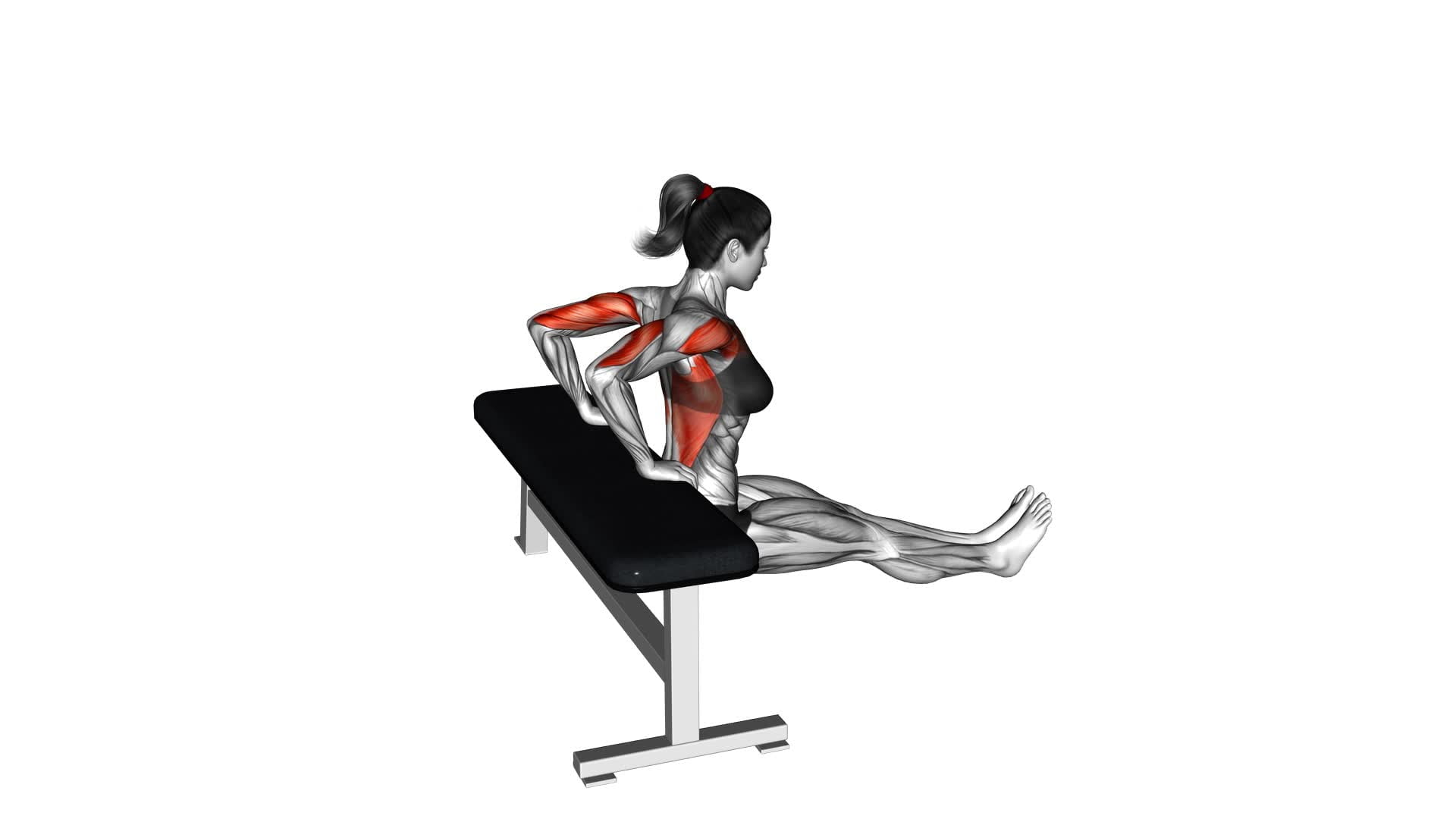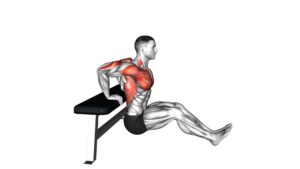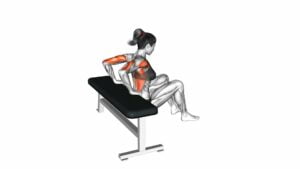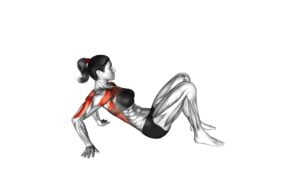Bench Dip on Floor (Female) – Video Exercise Guide & Tips

Are you looking for a challenging and effective exercise to target your triceps? Look no further than the bench dip on the floor!
Watch This Exercise Video
This video exercise guide and tips specifically cater to female fitness enthusiasts. Discover the benefits, proper form, and equipment needed for bench dips.
Learn about modifications and progressions, common mistakes to avoid, and valuable tips for maximizing your results.
Get ready to strengthen and tone your arms with this powerful exercise.
Key Takeaways
- Bench dips are beneficial for females as they help in developing upper body strength.
- They target triceps, chest, and shoulder muscles, leading to improved overall fitness level.
- Bench dips can be customized with different variations, allowing for progression and increased difficulty.
- It is important to maintain proper form and technique, avoiding common mistakes such as arching the back and flaring the elbows.
Benefits of Bench Dips for Females
You will experience several benefits from incorporating bench dips into your workout routine as a female. One of the main advantages is the development of upper body strength. Bench dips specifically target your triceps, chest, and shoulder muscles, helping to tone and strengthen them. This increased upper body strength can greatly enhance your overall fitness level and improve your performance in other exercises.
Another benefit of bench dips is the variety of variations available. By adjusting the position of your hands or feet, you can target different muscle groups and add variety to your routine. For example, you can perform narrow grip bench dips to focus more on your triceps, or wide grip bench dips to engage your chest muscles more. Additionally, you can elevate your feet on a bench or stability ball to increase the difficulty and engage your core muscles.
Incorporating bench dips into your workout routine as a female can have numerous benefits. Not only will you develop upper body strength, but you'll also have the flexibility to customize your workouts with different variations. So, go ahead and give bench dips a try to experience these benefits and take your fitness to the next level.
Proper Form and Technique
To ensure proper form and technique while performing bench dips on the floor, use a stable surface and maintain a straight body position throughout the exercise. Here are some tips to help you maximize your results and avoid common mistakes:
- Keep your hands shoulder-width apart on the bench or stable surface, with your fingers pointing forward.
- Lower your body by bending your elbows, making sure to keep them close to your body throughout the movement.
- As you lower yourself, aim to create a 90-degree angle at your elbows, and then push yourself back up to the starting position using your triceps.
Common mistakes to avoid while performing bench dips on the floor include:
- Arching your back: Keep your back straight and avoid arching to prevent strain on your lower back.
- Flaring your elbows: Keep your elbows close to your body to target your triceps effectively and avoid unnecessary strain on your shoulders.
- Relying on momentum: Focus on using your triceps to lift and lower your body, rather than relying on momentum to complete the movement.
Equipment Needed for Bench Dips
To perform bench dips, you'll need a stable bench or chair. Make sure it's sturdy and can support your body weight.
If you don't have access to any equipment, you can also do dips on the floor using your own body weight.
Necessary Equipment for Dips
To perform bench dips, you'll need only a sturdy bench or chair. Here are some other necessary equipment and alternative dip exercises you might find helpful:
- Weighted vest or belt: If you want to increase the intensity of your bench dips, you can add extra weight by using a weighted vest or belt.
- Parallel bars: If you prefer a more advanced version of dips, you can use parallel bars instead of a bench. This allows for a greater range of motion and engages more muscles.
- Resistance bands: To modify bench dips and make them easier, you can use resistance bands to assist with the movement. This helps to reduce the weight you have to lift and gradually build strength.
No Equipment Bench Dips
For no equipment bench dips, all you need is a sturdy bench or chair. These exercises are a great way to target your triceps and build upper body strength without the need for any additional equipment.
To perform a bench dip, start by sitting on the edge of the bench with your hands gripping the edge of the seat. Extend your legs out in front of you, with your heels touching the ground.
Lower your body down by bending your elbows, keeping your back close to the bench. Once your upper arms are parallel to the ground, push yourself back up to the starting position.
To make the exercise easier, you can bend your knees and keep your feet closer to your body. This reduces the amount of weight you have to lift and increases muscle activation in your triceps.
Modifications and Progressions
Let's talk about some modifications and progressions you can try with the bench dip exercise.
If you're a beginner, there are easier modifications you can do to make the exercise more manageable.
On the other hand, if you're more advanced, there are challenging progressions that can help you take your workout to the next level.
It's also important to keep safety in mind when making modifications, so I'll share some tips to help you stay injury-free.
Easier Modifications for Beginners
Start by performing a modified version of the bench dip exercise to make it easier for beginners. This will help you build strength and confidence before moving on to more challenging variations. Here are three beginner modifications to try:
- Use a stable chair or step instead of a bench to decrease the range of motion and make the exercise less intense.
- Bend your knees and keep your feet on the ground to provide additional support and stability.
- Start with shallow dips by only bending your elbows slightly. As you get stronger, gradually increase the depth of your dips.
These variations for beginners will allow you to focus on proper form and gradually increase the difficulty of the exercise.
Once you feel comfortable with these modifications, you can move on to more challenging progressions for advanced individuals.
Challenging Progressions for Advanced
To advance your bench dip exercise, try incorporating challenging progressions and modifications that will push you further in your fitness journey.
As you become more proficient in the basic bench dip, you can start adding intensity by using additional weight. Try placing a weighted plate on your lap or wearing a weighted vest to increase the resistance.
Another advanced progression is to elevate your feet on an elevated surface such as a bench or step. This will increase the difficulty by placing more emphasis on your triceps and shoulders.
Additionally, you can try performing the bench dip on parallel bars or dipping rings to challenge your stability and engage different muscle groups.
Remember to always maintain proper form and listen to your body to prevent injury during advanced progressions and modifications.
Safety Tips for Modifications
As you progress in your bench dip exercise and incorporate challenging modifications and progressions, it's important to prioritize safety to prevent injury and ensure effective results. Here are some safety tips for modifications:
- Start with easier modifications: If you're new to bench dips or have any limitations, begin with modifications that decrease the intensity. This might include using a shorter bench or chair, or performing the exercise with bent knees.
- Maintain proper form: Regardless of the modification you choose, it's crucial to maintain proper form throughout the exercise. Keep your back straight, engage your core, and avoid excessive shoulder or wrist movements.
- Gradually increase difficulty: As you become more comfortable, you can gradually progress to more challenging modifications. This might involve elevating your feet, increasing the range of motion, or adding resistance using weights or resistance bands.
By following these safety tips and gradually progressing, you can continue to challenge yourself while minimizing the risk of injury.
Remember to listen to your body and modify the exercise as needed to ensure a safe and effective workout.
Common Mistakes to Avoid
Avoiding common mistakes is crucial when performing the bench dip on the floor exercise. By being aware of these common mistakes, you can ensure that you're getting the most out of your workout and reducing the risk of injury. Here are some technique tips to help you avoid these mistakes and perform the exercise correctly.
One common mistake is allowing your elbows to flare out to the sides during the dip. This not only puts unnecessary strain on your shoulders but also reduces the effectiveness of the exercise. Instead, keep your elbows close to your sides throughout the movement.
Another mistake isn't fully extending your arms at the top of the dip. This limits the range of motion and makes the exercise less effective. Make sure to fully straighten your arms at the top of the movement to engage your triceps properly.
Lastly, avoid rushing through the exercise. Performing the bench dip too quickly can compromise your form and increase the risk of injury. Take your time and focus on maintaining proper form throughout the entire movement.
Tips for Maximizing Results
To maximize your results, incorporate these key strategies into your bench dip on the floor exercise routine:
- Increase the intensity: To maximize gains, try adding resistance to your bench dip by using a weighted vest or holding a dumbbell between your feet. This advanced technique will challenge your muscles and help you achieve greater strength and muscle definition.
- Focus on form: Proper form is crucial for maximizing results. Make sure to keep your elbows close to your body and your shoulders down throughout the exercise. Avoid swinging or using momentum to perform the movement. By maintaining strict form, you'll effectively target your triceps and avoid unnecessary strain on your joints.
- Vary your tempo: Another advanced technique to maximize gains is to vary the tempo of your bench dip. Try slowing down the lowering phase of the exercise to increase time under tension and stimulate muscle growth. You can also experiment with explosive movements during the upward phase to engage your fast-twitch muscle fibers.
By incorporating these strategies into your bench dip on the floor routine, you can take your workout to the next level and achieve optimal results.
Remember to always listen to your body and adjust the intensity and technique according to your fitness level.
Frequently Asked Questions
How Many Calories Can You Burn From Doing Bench Dips?
Bench dips are a great exercise for calorie burning benefits. By incorporating variations of bench dips into your workout routine, you can maximize the number of calories burned.
Whether you add weights or perform the exercise at a faster pace, these modifications increase the intensity and ultimately the calorie burn.
Can Bench Dips Help Tone and Strengthen the Triceps?
Bench dips are a great triceps exercise that can help tone and strengthen your arms. By targeting the triceps muscles, bench dips can help you achieve more defined and sculpted arms.
The benefits of bench dips extend beyond aesthetics, as they also improve upper body strength and stability. Incorporating bench dips into your workout routine can be an effective way to target and strengthen your triceps.
Are Bench Dips Suitable for Beginners or Should They Be Done by More Advanced Individuals?
Bench dips can be suitable for both beginners and more advanced individuals. However, it's important to focus on proper form to avoid injury.
Beginners should start with modified versions, using a bench or step to support their legs. As you progress, you can increase the intensity by placing your feet on a higher surface.
Remember to keep your elbows close to your body and engage your triceps while performing the exercise.
Can Bench Dips Help Improve Overall Upper Body Strength?
Bench dips are a great exercise for improving overall upper body strength. They target the triceps, shoulders, and chest muscles.
In addition to bench dips, there are other exercises you can incorporate into your workout routine to further enhance your upper body strength, such as push-ups, pull-ups, and shoulder presses.
The benefits of including bench dips in your routine include increased muscle tone, improved stability, and enhanced functional strength for daily activities.
How Often Should Bench Dips Be Incorporated Into a Workout Routine to See Noticeable Results?
To see noticeable results from bench dips, you should incorporate them into your workout routine regularly. The frequency of bench dips in your routine depends on your fitness level and goals, but aiming for 2-3 times per week is a good starting point.
Consistency is key! It's important to give yourself enough time to see results, so be patient. With consistent effort and proper form, you can expect to see improvements in your upper body strength within a few weeks.
Conclusion
In conclusion, bench dips are an effective exercise for females that target the triceps and upper body muscles.
By maintaining proper form and technique, using the necessary equipment, and avoiding common mistakes, women can maximize their results and see improvements in strength and muscle tone.
Remember to gradually progress and modify the exercise as needed to challenge yourself and continue to see progress.
Incorporating bench dips into your fitness routine can lead to a stronger and more toned upper body.

Author
Years ago, the spark of my life’s passion ignited in my mind the moment I stepped into the local gym for the first time. The inaugural bead of perspiration, the initial endeavor, the very first surge of endorphins, and a sense of pride that washed over me post-workout marked the beginning of my deep-seated interest in strength sports, fitness, and sports nutrition. This very curiosity blossomed rapidly into a profound fascination, propelling me to earn a Master’s degree in Physical Education from the Academy of Physical Education in Krakow, followed by a Sports Manager diploma from the Jagiellonian University. My journey of growth led me to gain more specialized qualifications, such as being a certified personal trainer with a focus on sports dietetics, a lifeguard, and an instructor for wellness and corrective gymnastics. Theoretical knowledge paired seamlessly with practical experience, reinforcing my belief that the transformation of individuals under my guidance was also a reflection of my personal growth. This belief holds true even today. Each day, I strive to push the boundaries and explore new realms. These realms gently elevate me to greater heights. The unique combination of passion for my field and the continuous quest for growth fuels my drive to break new ground.



